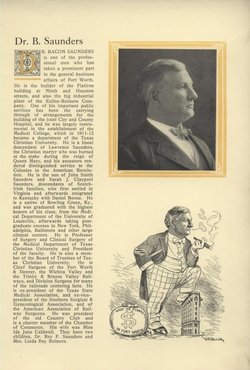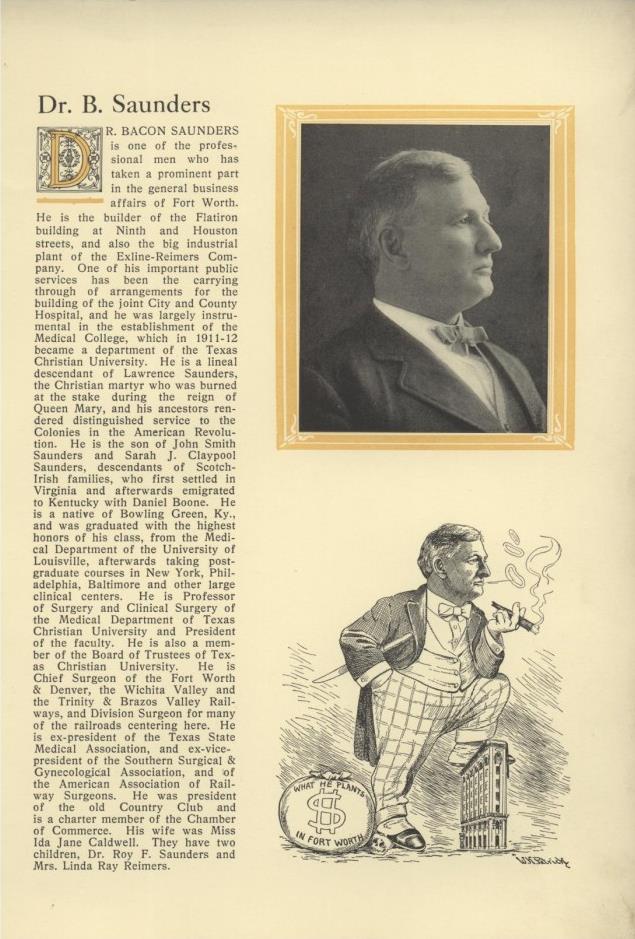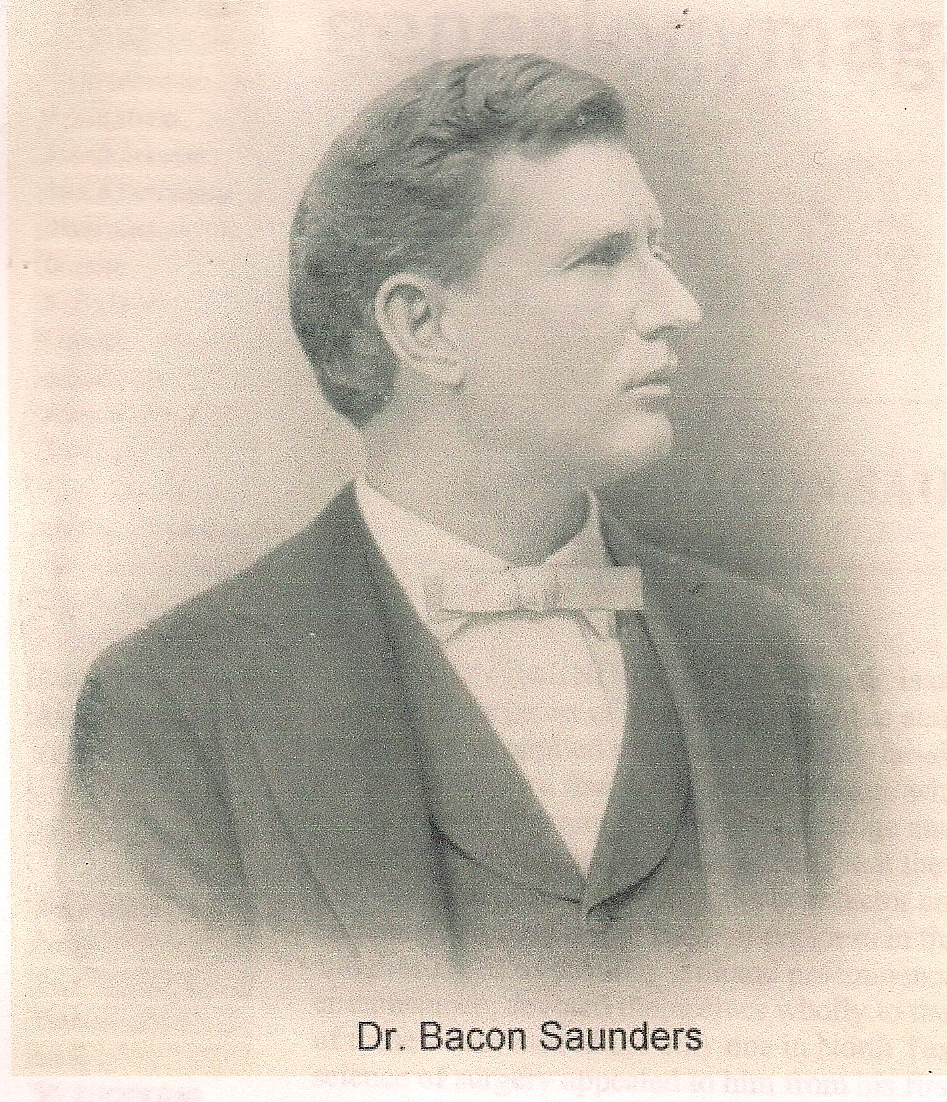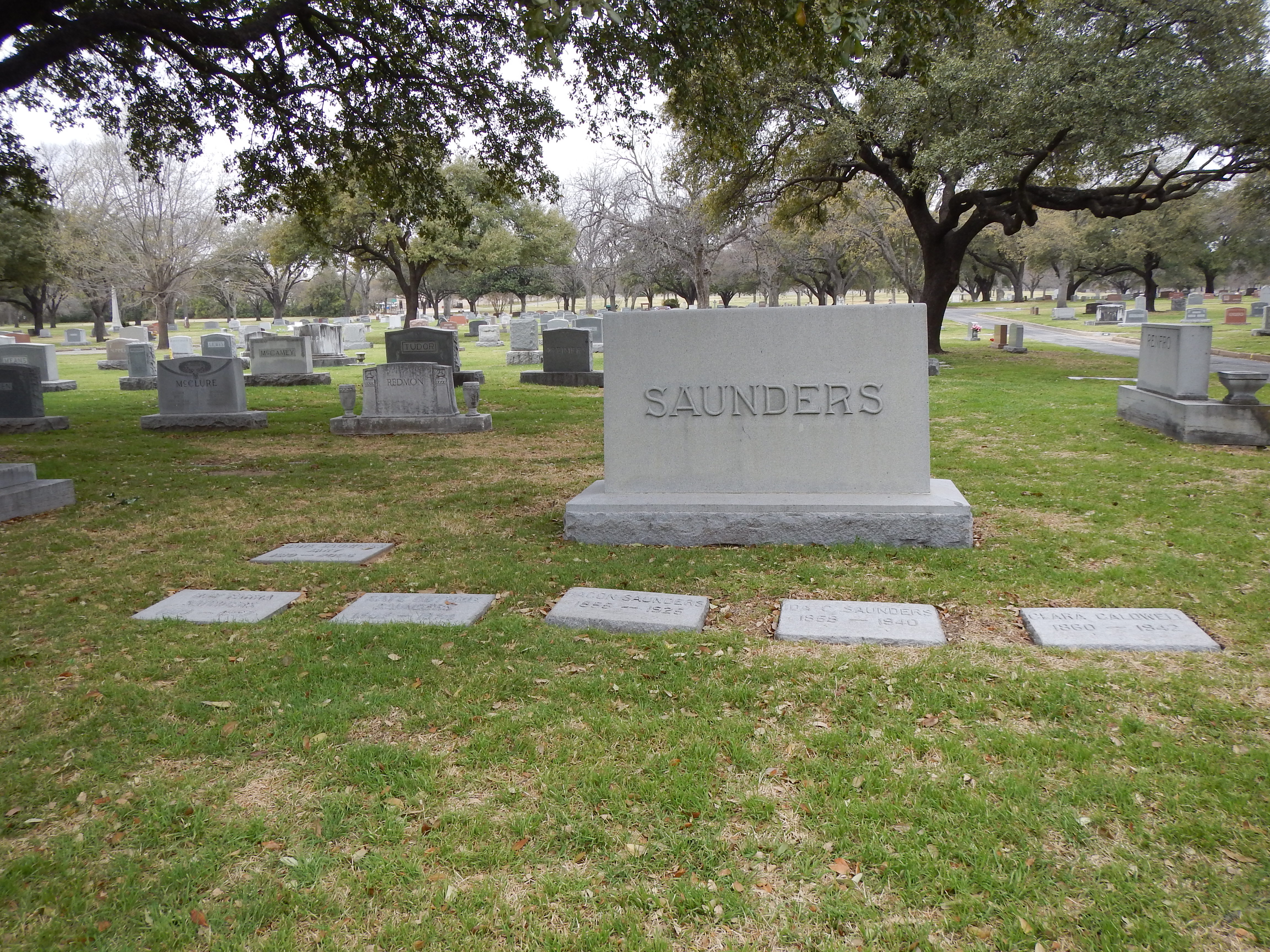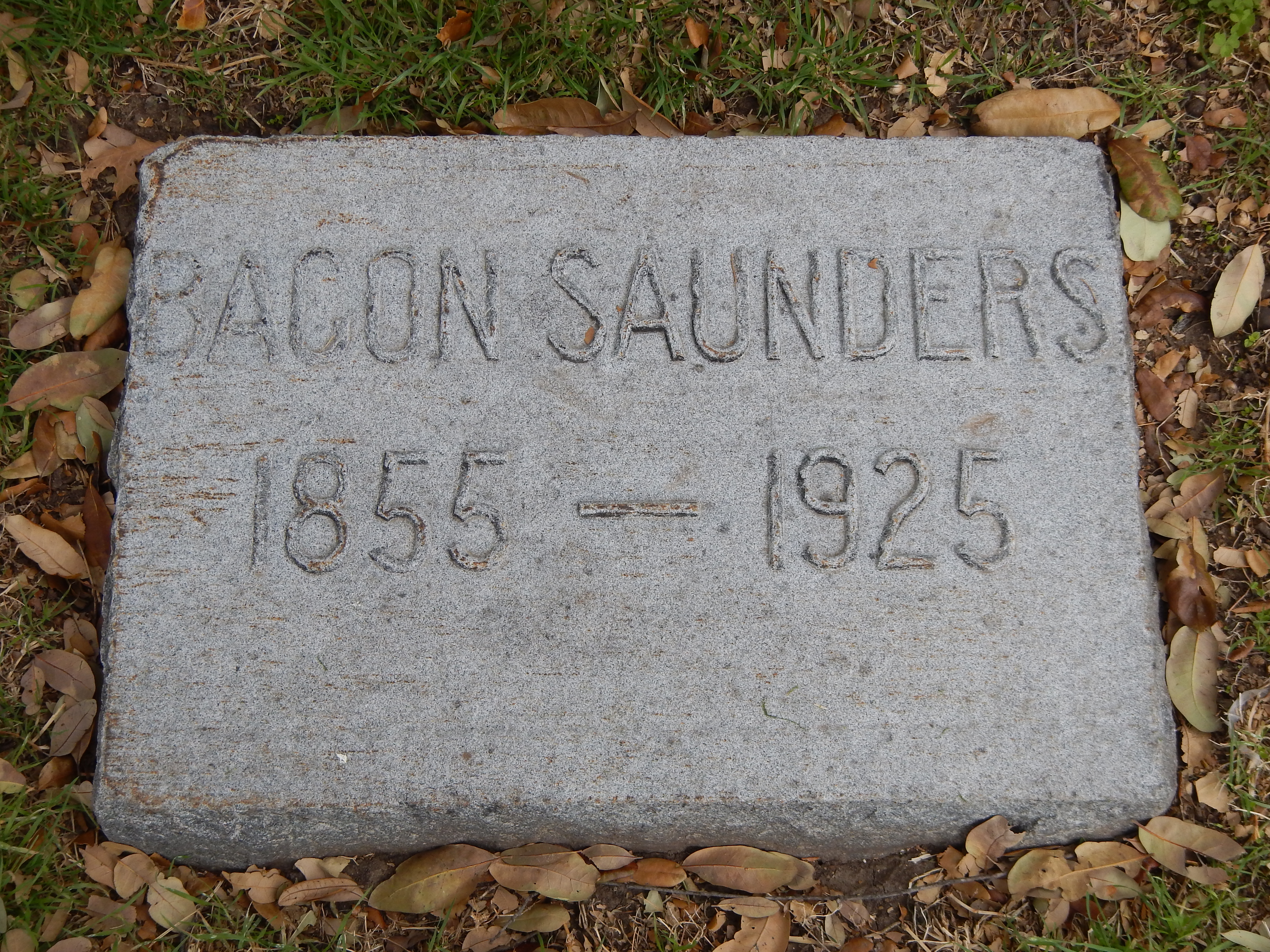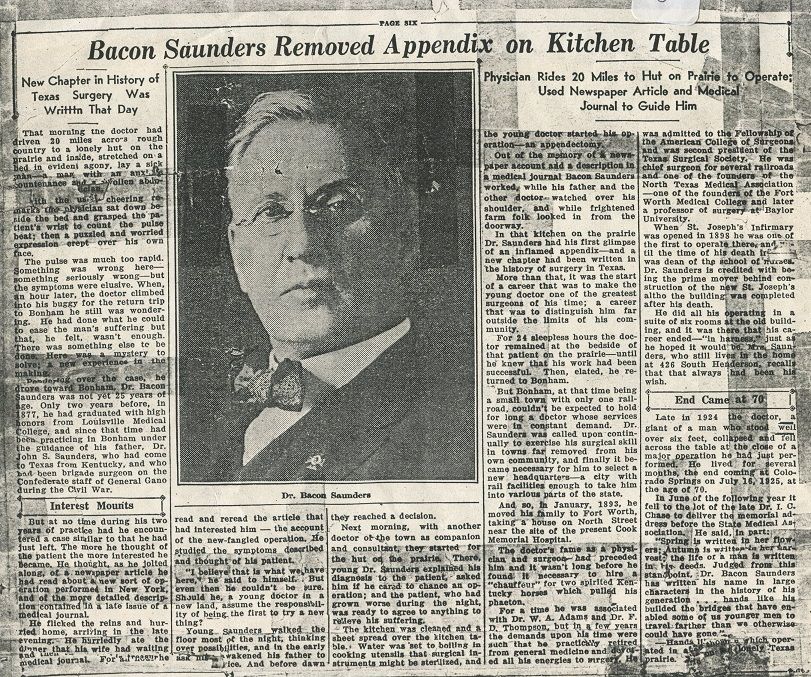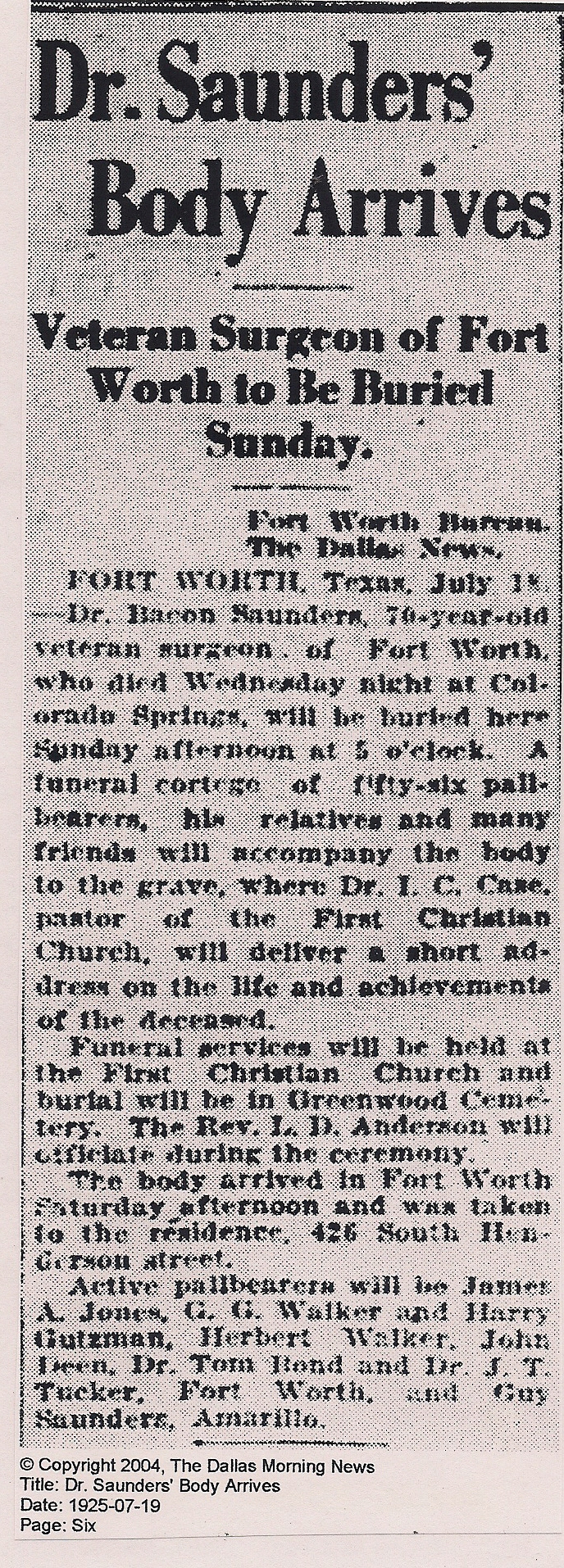is one of the best known and most successful surgeons of Texas and the entire south. Sur- gery is today the greatest of all applied sciences, and many far-sighted men believe that it is a question of only a few decades in the future when the knowledge of the physician will be- come universal knowledge and his profession will lose its distinctive importance to mankind, and
that the surgeon with his skill will take his present ally's place as the benefactor and final re- sort of suffering humanity. At the present
stage of progress in this direction only a very
few, and those men of peculiar skill and pre- eminence, have, through choice or circumstance, devoted themselves wholly to the practice of surgery, and one of these—and indeed the only one in North Texas—is Dr. Saunders. The
science of surgery appealed to him from his first introduction to it, the unusual skill early exhibited in operations marked plainly the leadings
into that branch of the profession, and his fore- most merit and rank in the art have now for some years claimed his services as surgical specialist to the exclusion of all allied interests. A Kentuckian by birth, though identified with North Texas practically all his life, Dr. Saunders was born at Bowling Green, January 5, 1855, Occupying as he does front rank in his profession, he none the less regards with more than
parental veneration the life and career of his father, Dr. John Smith Saunders, who in his time was one of the best of old-school physicians, and through the influence of whose example it was that the son adopted the medical profession. Dr. John Smith Saunders, who was
born at Glasgow, Kentucky, after attaining high
standing in the medical profession in his native state, in 1857 came to Dallas, Texas, then
situated almost on the frontier. As a pioneer doctor at this place in the years immediately preceding the war he became known over a wide
surrounding territory. His visits across the
sparsely settled country, bearing cheer and heal- ing to the isolated families, often penetrated into Tarrant county, and to the easy-circumstanced
dweller in town or city of the present day imagination alone must picture the hardships which
the good doctor encountered on these horse- back journeys, with his medicines packed irt his saddlebags, or the joy with which he was hailed by the ' suffering, who had perhaps awaited, his coming for days, whereas in this age the same number of hours would seem long, and who
would not see him again on his rounds for several weeks. Filling the place of friend, counselor and
helper, his part in the life of that historical epoch
is none the less important because it was unostentatiously performed. He thus continued to practice at Dallas until the war came on. A
Kentuckian, it is not strange that his admiration
for his fellow citizen Henry Gay m^de him an
adherent of old-line Whig principles, and when
the question of secession came up for settlement, though a firm believer in state rights, he op- posed the separation from the Union. But, like Lewis T. Wigfall, whom he so admired, and
like hundreds of conspicuous and eminent southerners his loyalty to Dixie, when the issue came
to settlement, aligned him without hesitation with
the Confederacy. Enlisting in 1862, he was
appointed brigade surgeon on the staff of General R. M. Gano, and as such served till the
close of the war. On his return to Dallas he de- cided to give up the practice of medicine, and
for several years during that period of industrial prostration following the war he took a prominent part in business affairs. He built and operated the first steam mill at Dallas, and was also in the mercantile business, until the
failure of his health obliged him to retire. His
children were then at the age where they need- ed better educational facilities than were afford- ed at Dallas, and this was the prime consideration that induced him to move to Bonham in 1869. There he built up a large general practice, and lived until his death in 1891. He at one time served as president of the North Texas
Medical Association, and stood very high among
the members of his profession. Noteworthy
and successful though he was as a physician,
his character was of those proportions that in- terest adheres more in the man than in his works. Of firm and positive convictions, he commanded respect and wielded influence among
men as a leader, although he never used the
qualities for any kind of political preferment, and the most important position he held was
as brigade surgeon during the war. In the
Christian church, however, he took a very active part, and was a devoted member till his death. Though his energies were almost constantly directed to serious affairs, yet he possessed the social qualities which attached men
to him through affection as well as respect. While he never posed as a raconteur, he was
an engaging story teller, and was especially fond of pointing a serious principle with an il- lustrative anecdote. Schools of a primitive time
supplied him with only the barest fundamentals upon which later insistent study and observation reared a most intimate knowledge of literature, men and events. His love for the classic in lit- erature never deserted him, and even in camp when surrounded by all the stern realities of
military life he was wont to read his Shakespeare aloud to his fellow officers, and such was his sympathetic acquaintance with that au- thor that it is said he knew half the plays by memory.
Such was the father, and it is from his character and example that the son has drawn much
of the power and practical idealism for success. Beginning his education in a private school taught in the Odd Fellows' hall at Dallas, in 1869, on the family's removal to Bonham, he
entered Carlton College, at that time one of
the highest grade institutions in East Texas.
Its founder and president had come from Missouri to Dallas, where he for a year or so presided over the above-mentioned school in the Odd Fellows' hall, and in 1867 moved to Bon- ham and established Carlton College. After
leaving this institution young Saunders taught
school for a time, and in the evenings and vacation intervals read medicine in his father's office. When a boy of seventeen, in 1872, he spent
132 HISTORY OF NORTH AND WEST TEXAS.
one vacation in the rough ranching life of the Texas frontier. Entering the medical depart- ment of the University of Louisville (Kentucky), he was graduated March i, 1877, with
the highest honors of his class, and at the early age of twenty-two began his professional career. A partnership with his father at Bonham
gave him a broad practical experience and .like- wise much repute for skill throughout the ter- ritory covered by their practice. His special aptitude for surgery had been shown during
his university career, and it was the surgical branch of the firm's practice to which he gave
special attention. His practice in Bonham continued until January, 1893, and the demands upon
his skill even then calling him far beyond his local residence, he moved to Fort Worth, where
the unexcelled railroad facilities would afford greater opportunity to care for his increasing patronage. At Fort Worth he became a part- ner in practice with the late W. A. Adams, who
afterward removed to St. Louis, and with F. D. Thompson of this city. During the five years in which this relation continued he de- voted some of his attention to general practice, although even then his skill in surgery brought him all the practice he could well care
for. It became necessary finally for him to re- linquish all work as medical practitioner, and though this transfer to a specialty was not easily made because of the insistence of his patrons that he continue to attend to general cases, for the past seven or eight years he has confined his professional work wholly to surgery and surgical diseases of women and to consultation in such cases. Dr. Saunders is one of the founders of the medical department of Fort Worth University, served ten years as its dean, and is secretary and
treasurer of the board of trustees, and also holds
the chair of principles and practice of surgery and clinical surgery in that institution. He is chief surgeon for the Fort Worth and Denver
( it\ Railroad, is division surgeon for the Texas
and Pacific, the Gulf, Colorado and Santa Fe,
the St. Louis and Southwestern, and the Inter- national and Great Northern, and is now vice president of the American Association of Railway Surgeons. His high position in medical
circles is attested by membership in the American Medical Association and high official positions in other well known organizations. He
was one of the founders and an ex-president
of the North Texas Medical Association
serving as president of that organization before
his father held the same position ; is ex-president
of the Texas State Medical Association; is exvice president of the International Railway Surgeons' Association ; and is past vice president also of the Southern Surgical and Gynecological Society, a body whose membership is restricted to those who have attained acknowledged skill in surgery, and its members are recognized as pre- eminent in the profession. It is as surgeon in charge of St. Joseph's Infirmary in Fort Worth
that Dr. Saunders does most of his hospital work.
Possessed of enormous energy and vitality, he
is able to use his skill in work that for effective- ness and quantity is seldom surpassed, and his record for successful major operations performed
day after day places him in class to himself. Within recent years in recognition of his high
standing in his profession, Dr. Saunders has been honored with the degree of LL. D. by the Arkansas Industrial University and by the State Normal University of Virginia. The active years
of his life have been completely engrossed with
his profession, and he has allowed no external
influences or pursuits to divert him from its mastery and successful prosecution. His only diversion from practice, absolutely essential to one who gives himself so completely to his work,
is a two-months' vacation each year, usually spent
in the Adirondack mountains with his family. His
offices, in the Saunders building at Fort Worth,
are finely equipped for surgical work.
Dr. Saunders was married at Bonham, October 30, 1877. to a prominent young lady of that
place, Miss Ida Caldwell, a native of Tennessee. She is prominent in Fort Worth society and is one of the lady members of the Texas World's
Fair commission and connected with various
other clubs. Dr. and Mrs. Saunders have two
children, Roy F. and Linda Ray. The son took
his degree in the medical department of the Fort Worth University in the spring of 1905, and
HISTORY OF NORTH AND WEST TEXAS. 133
at the present writing is pursuing post-graduate work in Jefferson Medical College at Philadelphia. He is thus the third generation to adopt
the medical profession, so that the name of Saunders will have enduring prominence in the annals of southern medicine and surgery.
Contributor: Nona Forrest (46501243)
is one of the best known and most successful surgeons of Texas and the entire south. Sur- gery is today the greatest of all applied sciences, and many far-sighted men believe that it is a question of only a few decades in the future when the knowledge of the physician will be- come universal knowledge and his profession will lose its distinctive importance to mankind, and
that the surgeon with his skill will take his present ally's place as the benefactor and final re- sort of suffering humanity. At the present
stage of progress in this direction only a very
few, and those men of peculiar skill and pre- eminence, have, through choice or circumstance, devoted themselves wholly to the practice of surgery, and one of these—and indeed the only one in North Texas—is Dr. Saunders. The
science of surgery appealed to him from his first introduction to it, the unusual skill early exhibited in operations marked plainly the leadings
into that branch of the profession, and his fore- most merit and rank in the art have now for some years claimed his services as surgical specialist to the exclusion of all allied interests. A Kentuckian by birth, though identified with North Texas practically all his life, Dr. Saunders was born at Bowling Green, January 5, 1855, Occupying as he does front rank in his profession, he none the less regards with more than
parental veneration the life and career of his father, Dr. John Smith Saunders, who in his time was one of the best of old-school physicians, and through the influence of whose example it was that the son adopted the medical profession. Dr. John Smith Saunders, who was
born at Glasgow, Kentucky, after attaining high
standing in the medical profession in his native state, in 1857 came to Dallas, Texas, then
situated almost on the frontier. As a pioneer doctor at this place in the years immediately preceding the war he became known over a wide
surrounding territory. His visits across the
sparsely settled country, bearing cheer and heal- ing to the isolated families, often penetrated into Tarrant county, and to the easy-circumstanced
dweller in town or city of the present day imagination alone must picture the hardships which
the good doctor encountered on these horse- back journeys, with his medicines packed irt his saddlebags, or the joy with which he was hailed by the ' suffering, who had perhaps awaited, his coming for days, whereas in this age the same number of hours would seem long, and who
would not see him again on his rounds for several weeks. Filling the place of friend, counselor and
helper, his part in the life of that historical epoch
is none the less important because it was unostentatiously performed. He thus continued to practice at Dallas until the war came on. A
Kentuckian, it is not strange that his admiration
for his fellow citizen Henry Gay m^de him an
adherent of old-line Whig principles, and when
the question of secession came up for settlement, though a firm believer in state rights, he op- posed the separation from the Union. But, like Lewis T. Wigfall, whom he so admired, and
like hundreds of conspicuous and eminent southerners his loyalty to Dixie, when the issue came
to settlement, aligned him without hesitation with
the Confederacy. Enlisting in 1862, he was
appointed brigade surgeon on the staff of General R. M. Gano, and as such served till the
close of the war. On his return to Dallas he de- cided to give up the practice of medicine, and
for several years during that period of industrial prostration following the war he took a prominent part in business affairs. He built and operated the first steam mill at Dallas, and was also in the mercantile business, until the
failure of his health obliged him to retire. His
children were then at the age where they need- ed better educational facilities than were afford- ed at Dallas, and this was the prime consideration that induced him to move to Bonham in 1869. There he built up a large general practice, and lived until his death in 1891. He at one time served as president of the North Texas
Medical Association, and stood very high among
the members of his profession. Noteworthy
and successful though he was as a physician,
his character was of those proportions that in- terest adheres more in the man than in his works. Of firm and positive convictions, he commanded respect and wielded influence among
men as a leader, although he never used the
qualities for any kind of political preferment, and the most important position he held was
as brigade surgeon during the war. In the
Christian church, however, he took a very active part, and was a devoted member till his death. Though his energies were almost constantly directed to serious affairs, yet he possessed the social qualities which attached men
to him through affection as well as respect. While he never posed as a raconteur, he was
an engaging story teller, and was especially fond of pointing a serious principle with an il- lustrative anecdote. Schools of a primitive time
supplied him with only the barest fundamentals upon which later insistent study and observation reared a most intimate knowledge of literature, men and events. His love for the classic in lit- erature never deserted him, and even in camp when surrounded by all the stern realities of
military life he was wont to read his Shakespeare aloud to his fellow officers, and such was his sympathetic acquaintance with that au- thor that it is said he knew half the plays by memory.
Such was the father, and it is from his character and example that the son has drawn much
of the power and practical idealism for success. Beginning his education in a private school taught in the Odd Fellows' hall at Dallas, in 1869, on the family's removal to Bonham, he
entered Carlton College, at that time one of
the highest grade institutions in East Texas.
Its founder and president had come from Missouri to Dallas, where he for a year or so presided over the above-mentioned school in the Odd Fellows' hall, and in 1867 moved to Bon- ham and established Carlton College. After
leaving this institution young Saunders taught
school for a time, and in the evenings and vacation intervals read medicine in his father's office. When a boy of seventeen, in 1872, he spent
132 HISTORY OF NORTH AND WEST TEXAS.
one vacation in the rough ranching life of the Texas frontier. Entering the medical depart- ment of the University of Louisville (Kentucky), he was graduated March i, 1877, with
the highest honors of his class, and at the early age of twenty-two began his professional career. A partnership with his father at Bonham
gave him a broad practical experience and .like- wise much repute for skill throughout the ter- ritory covered by their practice. His special aptitude for surgery had been shown during
his university career, and it was the surgical branch of the firm's practice to which he gave
special attention. His practice in Bonham continued until January, 1893, and the demands upon
his skill even then calling him far beyond his local residence, he moved to Fort Worth, where
the unexcelled railroad facilities would afford greater opportunity to care for his increasing patronage. At Fort Worth he became a part- ner in practice with the late W. A. Adams, who
afterward removed to St. Louis, and with F. D. Thompson of this city. During the five years in which this relation continued he de- voted some of his attention to general practice, although even then his skill in surgery brought him all the practice he could well care
for. It became necessary finally for him to re- linquish all work as medical practitioner, and though this transfer to a specialty was not easily made because of the insistence of his patrons that he continue to attend to general cases, for the past seven or eight years he has confined his professional work wholly to surgery and surgical diseases of women and to consultation in such cases. Dr. Saunders is one of the founders of the medical department of Fort Worth University, served ten years as its dean, and is secretary and
treasurer of the board of trustees, and also holds
the chair of principles and practice of surgery and clinical surgery in that institution. He is chief surgeon for the Fort Worth and Denver
( it\ Railroad, is division surgeon for the Texas
and Pacific, the Gulf, Colorado and Santa Fe,
the St. Louis and Southwestern, and the Inter- national and Great Northern, and is now vice president of the American Association of Railway Surgeons. His high position in medical
circles is attested by membership in the American Medical Association and high official positions in other well known organizations. He
was one of the founders and an ex-president
of the North Texas Medical Association
serving as president of that organization before
his father held the same position ; is ex-president
of the Texas State Medical Association; is exvice president of the International Railway Surgeons' Association ; and is past vice president also of the Southern Surgical and Gynecological Society, a body whose membership is restricted to those who have attained acknowledged skill in surgery, and its members are recognized as pre- eminent in the profession. It is as surgeon in charge of St. Joseph's Infirmary in Fort Worth
that Dr. Saunders does most of his hospital work.
Possessed of enormous energy and vitality, he
is able to use his skill in work that for effective- ness and quantity is seldom surpassed, and his record for successful major operations performed
day after day places him in class to himself. Within recent years in recognition of his high
standing in his profession, Dr. Saunders has been honored with the degree of LL. D. by the Arkansas Industrial University and by the State Normal University of Virginia. The active years
of his life have been completely engrossed with
his profession, and he has allowed no external
influences or pursuits to divert him from its mastery and successful prosecution. His only diversion from practice, absolutely essential to one who gives himself so completely to his work,
is a two-months' vacation each year, usually spent
in the Adirondack mountains with his family. His
offices, in the Saunders building at Fort Worth,
are finely equipped for surgical work.
Dr. Saunders was married at Bonham, October 30, 1877. to a prominent young lady of that
place, Miss Ida Caldwell, a native of Tennessee. She is prominent in Fort Worth society and is one of the lady members of the Texas World's
Fair commission and connected with various
other clubs. Dr. and Mrs. Saunders have two
children, Roy F. and Linda Ray. The son took
his degree in the medical department of the Fort Worth University in the spring of 1905, and
HISTORY OF NORTH AND WEST TEXAS. 133
at the present writing is pursuing post-graduate work in Jefferson Medical College at Philadelphia. He is thus the third generation to adopt
the medical profession, so that the name of Saunders will have enduring prominence in the annals of southern medicine and surgery.
Contributor: Nona Forrest (46501243)
Family Members
Sponsored by Ancestry
Advertisement
Explore more
Sponsored by Ancestry
Advertisement
